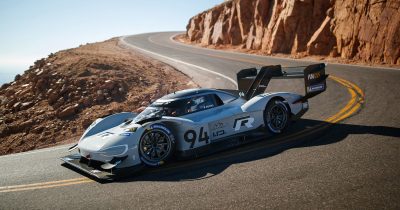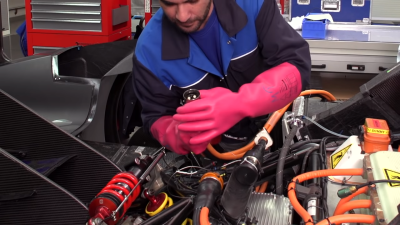
When we think of electric cars, more often than not we’re drawn to the environmental benefits and the smooth quiet commuter drives they’re so ideally suited for. However, EVs can also offer screaming performance, most notably due to their instant-on torque that gives them a big boost over internal combustion vehicles.
In recent years, this has led to a variety of independent and manufacturer-supported efforts taking on some of motorsport’s classic events. Today, we’re looking at a handful of recent entries that have tackled one of the most gruelling events in motorsport – the Pikes Peak International Hillclimb.
History

For those unfamiliar, the Pikes Peak International Hill Climb, also popularly nicknamed The Race To The Clouds, is an event run on the highway leading up the mountain of Pikes Peak in Colorado. The 12.42 mile course is a twisted ribbon of tarmac that climbs over 14,000 ft above sea level. (The road was formerly dirt before environmental concerns led to it being gradually paved in recent decades.) The course is known for its treacherous dropoffs that have claimed multiple lives over the years, as well as the famous Climb Dance short film that depicts Ari Vatanen climbing the mountain in the 1988 event in his turbocharged Peugeot 405 T16.

The relatively short distance of the hillclimb suits electric vehicles, which are less capable at longer events involving multiple laps, due to the limitations of battery storage. The tight, winding course also allows EVs to make the benefit of their low-end torque advantage and, in most cases, lack of need to shift gears. It’s thus possible to build a relatively lightweight EV with just enough range to complete the Pikes Peak course on a full charge and be competitive with the times set by internal combustion rivals.
There’s a long history of electric cars competing at the event, with one of the first entrants being Joe Ball in 1981, completing the course in just over 32 minutes in a Sears Electric Car – though well over double the time taken by typical gasoline-fuelled competitors. The first electric entry to break the 20 minute barrier was a Honda Civic Shuttle-based entry, piloted by Katy Endicott in 1994 with a time of 15:44.710. Legendary driver Nobuhiro Tajima was the first to break the ten minute barrier on the now-paved run in 2013, with a time of 9:46.530 in his custom-built E-RUNNER Pikes Peak Special.

In more recent years, the competition has heated up significantly as electric vehicle technology has progressed to the point of posing a real challenge to internal combustion rivals. With highly efficient motors, batteries capable of delivering huge currents, and charging technology able to keep a car running all day, the tide at Pikes Peak began to turn.
The race was first won by an electric car in 2015, with Rhys Millen behind the wheel of a custom electric racer, but it would be several more years before the outright course record was broken by an EV. The time came in 2018, when Romain Dumas piloted Volkswagen’s I.D.R to a scorching 7:57.148 run up the mountain, eclipsing the 8-minute barrier for the first time. Pikes Peak stands today as one of the first major motorsports events to fall to the march of the electric vehicle.
What It Takes

Running a competitive Pikes Peak entry is no mean feat, whatever the powertrain involved. There’s plenty of race engineering that goes on in terms of getting the correct suspension setup, aero balance, and to make sure tyre temperatures are optimised for the track surface and ambient conditions. Combine those with a world-class racing driver and you might have a shot at the title. But, when it comes down to running an electric vehicle, there’s a few unique challenges to overcome.

Pikes Peak is a mountain, after all, and not particularly well equipped to deliver huge gobs of electric current to bespoke racecars with empty batteries. Thus, teams must find a way to provide their own electricity.
In the case of a car like the Volkswagen ID.R, a giant generator was used, running off glycerol for cleaner emissions to avoid spoiling the environmental credentials of the exercise. Charging is done at rate of up to 90 kW, and completes in 20 to 30 minutes. This quick charging capability is necessary for a car competing at Pikes Peak, due to the potential short turnaround time between competitive runs. To avoid the batteries overheating, the batteries are actively cooled by fans in the pit area. Starting a run with hot batteries can compromise their current output, so it’s key to performance to keep them cool.

It’s also important to carefully consider the size of batteries on the vehicle. Unlike a liquid-fuelled car, which can be fuelled heavier or lighter depending on the exact amount of fuel needed for a run, an electric car has to carry the full weight of its batteries all the time.
Swappable or modular packs are possible, but can come with efficiency penalties due to power lost in connectors. Ideally, the pack will be sized just large enough to complete a single run before running too low on charge, to avoid the car having to carry excess weight which negatively impacts performance. A great example of the battery weight dilemma is the Palatov D2EV, which ran in the 2019 event. Set up for a 300-mile range on the street instead of pure performance on the 12.42 mile hillclimb, the car had to carry an extra 500 kg of batteries up the mountain, hurting the handling and dulling the acceleration.
Other problems faced on the mountain affect all racers more equally. Rain, snow or high winds are perilous for any vehicle on the course. There’s also the ever-present threat of simply sliding off the mountain, as guard rails are few and far between. Racers have faced these dangers for decades however, and electric vehicle or not, they’re not going away anytime soon.
Conclusion
It’s a simple fact that the torque delivery of electric vehicles is a huge advantage in performance situations. The main thing holding back electric vehicles from dominating more forms of motorsport is the limitation of battery technology, stopping them from competing on longer events like rallies or circuit races consisting of many laps. However, take that hurdle away, or simply race somewhere it doesn’t matter, like Pikes Peak, and suddenly the electric vehicle comes to dominate the legendary internal combustion engine of yore. As technology continues to improve, expect to see the same story told across the world of motorsport.
0 Commentaires